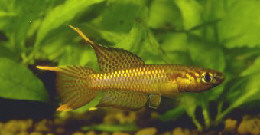Aphyosemion poliaki Amiet 1991

Ekona
Photo courtesy of Maurice Chauche & the
KCF website.
| Meaning of Name |
After Daniel Poliak, a well known aquarist who has worked with members of the Chromaphyosemion subgenus. | ||||||||||||||||||
| First Description |
Amiet J.L. 1991 Diagnoses de deux espéces nouvelles d'Aphyosemion du Cameroon (Teleostei: Aplocheilidae). Ichthyological Exploration of Freshwaters 2 (1): p 89-94, figures, map. | ||||||||||||||||||
| Size |
6 cm (Wildekamp 1993) | ||||||||||||||||||
| Meristics |
D = 12-13, A = 14-15 (Amiet 1991) | ||||||||||||||||||
| Karyotype |
n = 19, A = 20 | ||||||||||||||||||
| Sub-Genus |
Chromaphyosemion | ||||||||||||||||||
| Group |
| ||||||||||||||||||
| Synonyms |
| ||||||||||||||||||
Populations
|
ABC 06 / 121 - Coming from Douala, at the entrance to Mile 29 (before the turn), turn right. Stream in a rubber tree plantation. Collected with A.calliurum. Collected 27th January 2006 at 14.45 hours. ABK 07 / 152 - Collected at 16.45 hours on 20th January 2007 by Agnése et al at the entrance to Mile 29 from Muyuka. Also collected an Epiplatys sp. ABK 07 / 153 - Collected 20th January 2007 at 17.20 hours. District Mannion, from Mile 29 to Doula, track right along the plantation of rubber trees. Source crossing the road. A. poliaki, Cichlidae. Bolifamba -
Ekona -
HAH 98 / 305 - Mile 17
- Collected 12th June 1998 by Hrbek, Aspinwall & Heller. About
0.5 km south of the Mile 17 junction (Buea, Muea, Muntengene), on
the main road from Buea to Douala, in Bolifamba. Down a side road
going west to the Rehabilitation Centre for the Blind. First creek
on the path, about 0.5 km inland. The stream flows from north to south
and is not very rapid. Western side of the stream is cultivated with
bananas and coco-yams. The stream itself is has a number of fallen
trees, emergent reed like vegetation and numerous areas with caught
organic debris. Fish are found in more quiet areas behind fallen trees.
Exposed to sun, and not much like a 'typical' killifish habitat. Dark
colored bottom composed of large pebbles. Clean, clear water. Coordinates:
04°08'46" N 09°18'07" E, Elevation: 535 m, pH 7.6
TDS 110 µSi 0.16 Mile 29 - Readings taken
22nd January 1984 at 2 pm - Water temperature 22·8°C, pH
7, electrical conductivity 150 µs, total hardness 5°DH.
Water was clear. Area was in the open, without trees. Some overhanging
vegetation around edges. Stream was 3-5 metres wide & 30-40cm
deep. Base of stream covered with stones of volcanic origin.
Monea - Legros could not locate this collection point in his 1989 trip & considers it could be Muea (pronounced Mouia).
Mount Cameroon -
Muea - On the road betwen
Mutengene to Muyuka, less than 10 km before Ekona Yard, eastern slopes
of Mont Cameroon. sp. No.1 - Collected on the slopes of Mt. Cameroon at an altitude of 900 metres. | ||||||||||||||||||
| Type Locality |
Tamben, southwest Province, western Cameroon. | ||||||||||||||||||
| Distribution |
The eastern slopes of Mount Cameroon. Reported to inhabit altitudes of 250-600 metres above sea level. | ||||||||||||||||||
| Habitat |
Small mountain brooks. They are usually found
under overhanging vegetation. | ||||||||||||||||||
| Distinguishing Characteristics | |||||||||||||||||||
| Colour/Pattern Variability | Low | ||||||||||||||||||
| History |
| ||||||||||||||||||
| Breeding Notes |
I kept this species on the top row of my fish house on receipt from the wild in a well planted tank exposed to natural daylight. The fish were ragged on arrival but eventually recovered into fine specimens. No eggs were laid for about 6 months but they did lay in this set up, producing a few pairs to maintain & a few to distribute. Reports suggest a low temperature for breeding. This is in line with the high altitude (higher than any other Chromaphyosemion sp.) they inhabit. Sexual maturity is reached at 6-7 months of age. Jaroslav Kadlec in BKA newsletter No.363, December
1995 reports breeding them in a 1 litre jar with water of 1-2°DH,
pH 6/6·5, water temperature 20-26°C. It is essential to feed
them on live foods. Mosquito larvae & wingless fruit flies are a
favourite. He put washed peat as a base & used 2-3 females to 1
male. Fish were left in the tank for 5-10 hours. Eggs were water hatched. | ||||||||||||||||||
| Diameter of Egg | |||||||||||||||||||
| Remarks |
Newly imported commercial shipments are very ragged. Males appear to fight in the bags. I always put plenty of plants & mops in the tanks on receiving them & they do not show any hostility towards each other. |
References
https://www.killifische.info/west-africa/chromaphyosemion/poliaki/